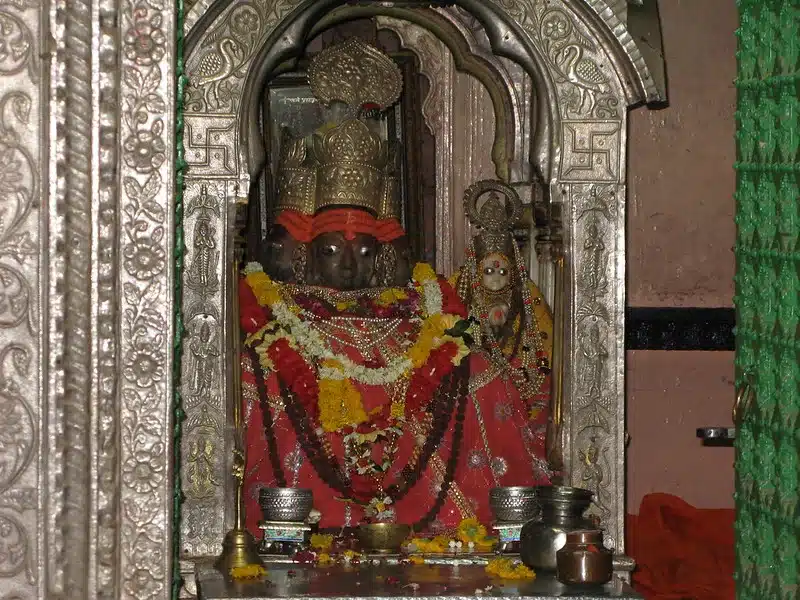Brahma Temple Pushkar One of the major thriving temple of Brahma, in Pushkar can be identified by it red spire and by the image of Hans (the swan considered sacred to Lord Brahma). This temple built with the marble is decorated with silver coin. Beside there is silver turtle on the floor of temple. The chaturmukhi (four faces) Brahma is idol is houseed in Garbha Griha or “Womb home” which is the sanctum sanctorum. Above the Garbha Griha a super structure called Shikhara is composed of many shikhara. Interestingly the marble staute of surya standing sentinel at the Brahma temple is shown wearing boot. It is a pointed out that while all gods are shown with the bare feet, the figure Surya wears an ancient warrior’s boot. This was considered a luxury accorded to him by the iconographers who did not want his feet to be scorched by the heat generated by him self. Mogul Emperor Aurangzeb is said to have destroyed this temple followed by a period of fear and confusion. The activities at Brahma temple were remained at low pitch. Later on a Brahman devotee named phundi bai first repaired in 1719. She was the mother of shambu ram and daughter of Girdhar Das, was resident of Jaipur. There after Maharaja Sawai Jai Singh rebuilt it in 1727. In 1809 Gokul Chand Parekh, a minister of scindias, repaired it at cost of Rs. 1,30,000.
Pushkar’s Brahma Temple: History
Pushkar is home to over 500 temples, including 80 large temples and many shrines (rebuilt from the ones destroyed during Mughal emperor Aurangzeb’s rule). The ‘garbagriha’ of the central Brahma temple—made of stone and marble slabs—dates back to the 14th century. The structure is believed to have been built by the legendary Sage Vishwamitra. Adi Shankara renovated it, and Maharaja Jawat Raj of Ratlam modified the current structure.
The temple features a shikhara (or tapering temple top) painted red with a captivating Hansa (swan) motif. Pushkar Lake and the Brahma Temple are among the ten most religious sites globally and one of the five sacred pilgrimage places for Hindus.
Historical Background
- The Brahma Temple was built in the fourteenth century, but its origins are thought to go back far longer. The existing structure is the result of centuries of repairs and reconstructions.
- According to legend, Lord Brahma performed a ritual sacrifice on the current location of the temple. He chose this spot because of the Pushkar Lake, which is thought to have formed when a lotus flower dropped from his palm.
- Despite being one of the most important deities in Hinduism, Lord Brahma has few temples devoted to him. The Brahma Temple in Pushkar is one of the most important and well-known of these.
Architectural Marvel
The temple’s building combines traditional Rajasthani style with aspects of ancient Hindu design. The Brahma Temple is built primarily from marble and stone, with specific elements that set it apart:
- Red Spire (Shikhara): The temple’s most remarkable feature is its red spire, which symbolises the temple’s holiness and special devotion to Lord Brahma.
- Silver Doorway:The temple entrance is characterised by an exquisite silver door that leads to the main hall.
- Garbhagriha (Sanctum Sanctorum): The sanctum houses the major deity of Lord Brahma, a four-faced figure that represents his omnipresence and oversees all directions. The marble idol is joined by an idol of his consort, Gayatri.
Spiritual Significance
- The temple carries great spiritual significance for Hindus, especially during the Kartik Poornima festival, which honours Lord Brahma. Thousands of pilgrims travel to Pushkar during this period to bathe in the holy waters of Pushkar Lake and seek Lord Brahma’s blessings.
- A trip to the Brahma Temple and a swim in Pushkar Lake on Kartik Poornima are said to be Hindu rituals that can atone for sins and lead to moksha, or salvation.
- The Brahma Temple is a significant point on the Hindu pilgrimage circuit, which includes Pushkar, one of the five holy dhams (sites of worship).
Religious Festivals and Activities
The most prominent event related with the Brahma Temple is Kartik Poornima, which takes place on the full moon in the Hindu month of Kartik (October/November). During this time, Pushkar hosts the renowned Pushkar Camel Fair, which is both a lively cultural festival and a significant religious gathering. Pilgrims from all across the country come to wash in the hallowed lake and pray at the temple.
Aside from the fair, the temple hosts a variety of religious festivals, aartis (prayer rituals), and special poojas all year long. These rites are a popular draw for both tourists and devotees, creating a bustling yet spiritual ambiance.
